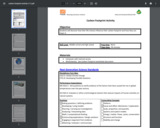
In this activity, students will examine their own carbon footprint and brainstorm ways they can lower it.
- Subject:
- Environmental Science
- Life Science
- Material Type:
- Activity/Lab
- Lesson Plan
- Date Added:
- 03/18/2024

In this activity, students will examine their own carbon footprint and brainstorm ways they can lower it.

Engineers perform energy audits to better understand how people use energy and identify ways people can conserve energy. Businesses and homeowners engage these engineers to help reduce their utility bills and help the environment. Recommendations often include using compact fluorescent light bulbs, lowering the thermostat temperature in the winter when the building is unoccupied, planting trees for shade, and improving insulation to reduce heat loss/gain.
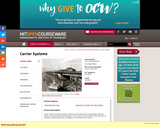
Carrier systems involve the design, operation, and management of transportation networks, assets, personnel, freight, and passengers. A number of different carrier systems are contrasted while models and tools for analyzing, optimizing, planning, managing, and controlling these systems are presented.

This video lesson aims to motivate students about chemistry and to raise their awareness about how chemistry helps in solving certain environmental problems. In this lesson, the air pollution problem created by cars and other vehicles is presented. The lesson will highlight causes of this problem, harmful products from it and possible solutions. There will also be discussion of ways to convert the pollutants produced by burning oil in vehicles into more friendly products.

Lesson plans and ideas for recognizing people that work in the forestry and environmental fields .

Two lessons and their associated activities explore cellular respiration and population growth in yeasts. Yeast cells are readily obtained and behave predictably, so they are very appropriate to use in middle school classrooms. In the first lesson, students are introduced to yeast respiration through its role in the production of bread and alcoholic beverages. A discussion of the effects of alcohol on the human body is used both as an attention-getting device, and as a means to convey important information at an impressionable age. In the associated activity, students set up a simple way to indirectly observe and quantify the amount of respiration occurring in yeast-molasses cultures. Based on questions that arise from this activity, in the second lesson students work in small groups as they design and execute their own experiments to determine how environmental factors affect yeast population growth.

Laboratory or field work in atmospheric science and oceanography. To be arranged with department faculty. Consult with department Education Office. This is an undergraduate introductory laboratory subject in ocean chemistry and measurement. There are three main elements to the course: oceanic chemical sampling and analysis, instrumentation development for the ocean environment, and the larger field of ocean science. This course is offered as part of the MIT/WHOI Joint Program in Oceanography/Applied Ocean Science and Engineering.
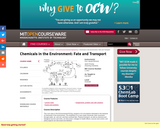
For Institute students in all departments interested in the behavior of chemicals in the environment (see ESD listings for other subjects). Emphasis on man-made chemicals, their movement through water, air, soil, and their eventual fate. Physical transport, as well as chemical and biological sources and sinks, are discussed. Linkages to health effects, sources and control, and policy aspects.
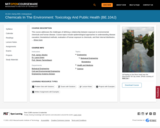
This course addresses the challenges of defining a relationship between exposure to environmental chemicals and human disease. Course topics include epidemiological approaches to understanding disease causation; biostatistical methods; evaluation of human exposure to chemicals, and their internal distribution, metabolism, reactions with cellular components, and biological effects; and qualitative and quantitative health risk assessment methods used in the U.S. as bases for regulatory decision-making. Throughout the term, students consider case studies of local and national interest.
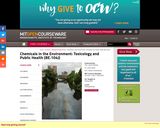
This course addresses the challenges of defining a relationship between exposure to environmental chemicals and human disease. Course topics include epidemiological approaches to understanding disease causation; biostatistical methods; evaluation of human exposure to chemicals, and their internal distribution, metabolism, reactions with cellular components, and biological effects; and qualitative and quantitative health risk assessment methods used in the U.S. as bases for regulatory decision-making. Throughout the term, students consider case studies of local and national interest.
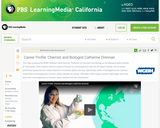
In this video produced for Teachers' Domain, learn about MIT professor Cathy Drennan's research into microorganisms that remove carbon dioxide, a greenhouse gas, from the atmosphere.
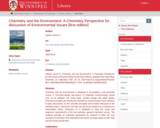
Chemistry and the Environment is designed to accompany a one-semester course in chemistry-based discussions of important environmental issues such as air pollution, the ozone layer, climate change and water quality. Chemical principles are introduced, followed by environmental ‘focus’ sections to base discussions on the scientific principles and societal intricacies of the individual topics. Instructors can also use the focus sections as a resource for presentation slides. Chemistry 2e is designed to meet the scope and sequence requirements of the two-semester general chemistry course. The textbook provides an important opportunity for students to learn the core concepts of chemistry and understand how those concepts apply to their lives and the world around them.
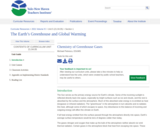
This unit will include an overview of the three main greenhouse gases (carbon dioxide, methane and nitrous oxide). The unit will be a mix of organic and inorganic chemistry and will describe the physical and chemical properties of the three main gases and the most important chemical reactions that move the greenhouse gases into and out of the atmosphere. The unit will include a chapter of chemical reactivity, how these gases work (by atmospheric absorption and scattering of electromagnetic waves at different wavelengths), their residence time in the atmosphere and analyze the mitigation (what humans can do to reduce or limit the concentration of greenhouse gases in the atmosphere).
One section of the unit will discuss the “global warming potential” (what makes a stronger or a weaker greenhouse gas) and the relationship between physical properties of greenhouse gases and their lifetime (how long they remain in the atmosphere).

Audubon Christmas Bird Count
The nation's longest-running community science bird project fuels Audubon's work throughout the year.

A pdf file that contains slides with visuals to be shown. It explains the CBC from its beginning to end with an example of Data taken from our local bird count.
Students will be instructed to build a data table and graph representing data. Then draw conclusions.

To increase students' awareness of possible invisible pollutants in drinking water sources, students perform an exciting lab requiring them to think about how solutions and mixtures exist even in unsuspecting places such as ink. They use alcohol and chromatography paper to separate the components of black and colored marker ink. Students witness first-hand how components of a solution can be separated, even when those individual components are not visible in solution.
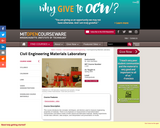
Introduces the concepts, techniques, and devices used to measure engineering properties of materials. Emphasis on measurement of load-deformation characteristics and failure modes of both natural and fabricated materials. Weekly experiments include data collection, data analysis, and interpretation and presentation of results.
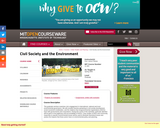
This graduate seminar examines the roles that civil society actors play in international, national, and local environmental governance. We will consider theories pertaining to civil society development, social movement mobilization, and relations between state and non-state actors. During the course of the semester, particular attention will be given to the legitimacy and accountability of nongovernmental organizations (NGOs). Case studies of civil society response to specific environmental issues will be used to illustrate theoretical issues and assess the impacts that these actors have on environmental policy and planning.

The push to modernize Mexico's water and sanitation systems not only saved human lives, it also spurred economic growth, as illustrated in this video segment adapted from Rx for Survival.
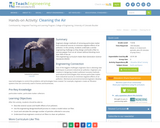
Engineers design methods of removing particulate matter from industrial sources to minimize negative effects of air pollution. In this activity, students will undertake a similar engineering challenge as they design and build a filter to remove pepper from an air stream without blocking more than 50% of the air.